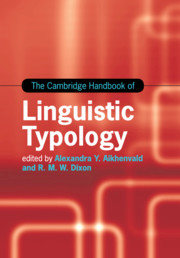
-
Select format
-
- Publisher:
- Cambridge University Press
- Publication date:
- 13 April 2017
- 30 March 2017
- ISBN:
- 9781316135716
- 9781107091955
- 9781107464889
- Dimensions:
- (247 x 174 mm)
- Weight & Pages:
- 2.15kg, 1026 Pages
- Dimensions:
- (244 x 170 mm)
- Weight & Pages:
- 1.3kg, 1028 Pages
- Subjects:
- Grammar and Syntax, Research Methods in Linguistics, English Language and Linguistics: General Interest, Language and Linguistics
- Collection:
- Cambridge Handbooks of Linguistics
You may already have access via personal or institutional login- Subjects:
- Grammar and Syntax, Research Methods in Linguistics, English Language and Linguistics: General Interest, Language and Linguistics
- Collection:
- Cambridge Handbooks of Linguistics
Book description
Linguistic typology identifies both how languages vary and what they all have in common. This Handbook provides a state-of-the art survey of the aims and methods of linguistic typology, and the conclusions we can draw from them. Part I covers phonological typology, morphological typology, sociolinguistic typology and the relationships between typology, historical linguistics and grammaticalization. It also addresses typological features of mixed languages, creole languages, sign languages and secret languages. Part II features contributions on the typology of morphological processes, noun categorization devices, negation, frustrative modality, logophoricity, switch reference and motion events. Finally, Part III focuses on typological profiles of the mainland South Asia area, Australia, Quechuan and Aymaran, Eskimo-Aleut, Iroquoian, the Kampa subgroup of Arawak, Omotic, Semitic, Dravidian, the Oceanic subgroup of Austronesian and the Awuyu-Ndumut family (in West Papua). Uniting the expertise of a stellar selection of scholars, this Handbook highlights linguistic typology as a major discipline within the field of linguistics.
Reviews
‘This Handbook provides a state-of-the-art survey of achievements and developments in the field of linguistic typology, covering the history of typology, phonological, morphological and syntactic typology, the relation of typology to historical linguistics, areal typology, sociolinguistic typology, and typological studies of sign languages. It takes account of all substantial typological studies published so far and adds a wealth of new data and analyses, based on the rich experience of the editors themselves and the expertise of a number of scholars of high competence in their respective fields.'
Lars Johanson - Johannes Gutenberg Universität Mainz, Germany
‘Edited by two of the world's leading typologists, this Handbook enables the reader to access a wealth of information on language structures far beyond those that have been covered in previous typological work.'
Bernd Heine - Universität zu Köln
Contents
Metrics
Altmetric attention score
Full text views
Full text views help Loading metrics...
Loading metrics...
* Views captured on Cambridge Core between #date#. This data will be updated every 24 hours.
Usage data cannot currently be displayed.
Accessibility standard: Unknown
Why this information is here
This section outlines the accessibility features of this content - including support for screen readers, full keyboard navigation and high-contrast display options. This may not be relevant for you.
Accessibility Information
Accessibility compliance for the PDF of this book is currently unknown and may be updated in the future.

